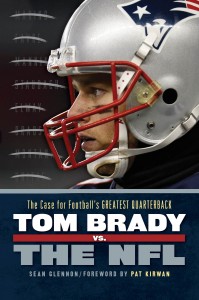Tom Brady vs. Peyton Manning Excerpt
With the next exciting installment of Tom Brady vs. Peyton Manning scheduled to take place late Sunday afternoon at Gillette Stadium, it seems like a good time to share a bit of what I wrote in my chapter on football’s all-time greatest quarterback rivalry in Tom Brady vs. the NFL: The Case for Football’s Greatest Quarterback.
This is just a little bit of the opening section of one of the longest chapters in the book.
There will never come a day when Tom Brady’s name isn’t connected with Peyton Manning’s. Not ever.
Brady and Manning are bound together like Bird and Magic, Ali and Frazier, McEnroe and Borg. If you want to discuss the greatness of one, you have to talk about how he stacks up against the other.
That’s the way it’s been since Brady emerged as an elite quarterback. And that’s the way it will continue to be. Even though the rivalry between Brady and Manning is fundamentally dissimilar to other classic sports rivalries.
Ali and Frazier traded punches. McEnroe and Borg traded shots … one athlete against another. And when a bout or a match was over, one guy had won and the other had lost. Simple.
Bird and Magic had teams around them, but they were still on the court at the same time. They faced each other. Each had an effect on the other’s performance.
Really, there’s no such thing as a true rivalry between individuals playing the same position in football. The game’s just not set up for it. Sure, Brady’s Patriots and Manning’s Colts squared off repeatedly during Manning’s tenure in Indianapolis — each team coming away with its share of big wins. But it’s not as if the two great quarterbacks ever actually engaged each other on the field.
At best, a meeting between two teams with star quarterbacks is like an American League pitchers’ duel — though in reverse, with the focus on offense rather than defense. Each of the big-name players knows he needs to find a way to put more points on the board than his rival, but neither ultimately has any direct effect on the other’s performance.
That makes it tough, if not impossible, to talk about a football rivalry in the context of a single game, or even a series of head-to-head matches.
You can look at stats, of course. You can try to assess leadership, a key component of the position. And if a game is tight, you can potentially look at how each player performs in the clutch. But in the end, each man is facing a different defense with different schemes and abilities. And neither can accomplish a thing without meaningful contributions from the other offensive players around him.
So when you start to talk about Brady and Manning, you can, if you like, look at the results of the twelve meetings between the Pats and Colts in which Brady and Manning were calling signals. And if you do, you’ll see that Brady and the Patriots went 8-4 overall, 6-3 in the regular season and 2-1 in the playoffs. That’s a winning average of .667 across the board. Look just a bit closer and you might also note that Brady’s Patriots had a winning record over Manning’s Colts both in Foxborough (5-2) and in Indianapolis (3-2).
And knowing all of that will get you almost nowhere.
So you want to read the whole thing now, right? There’s a purchase link on the info page here: Tom Brady vs. the NFL: The Case for Football’s Greatest Quarterback. Go get it.
Comments are closed.

